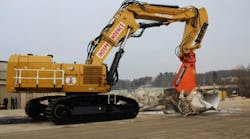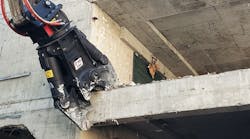Gary (Red) Bailes of Leslie Equipment puts his pickup truck into four-wheel drive and heads up the nearly vertical slope of the construction right-of-way to where the workers for ST Pipeline Inc. are installing the Big Sandy Pipeline. Building a 68-mile pipeline in the rugged mountains of eastern Kentucky requires four-wheel drive to get up and down the 50-percent slopes and also requires the ALLU SM Screener-Crusher to prepare the blasted and excavated sandstone for use as structural fill material.
Left: Big Sandy Pipeline proceeds through the rugged mountains of eastern Kentucky.The ALLU SM Screener-Crusher is a specialty attachment for loaders, excavators and backhoes. The device has rotating discs with hammers that pulverize and size material.
Leslie Equipment, an ALLU dealer headquartered in Cowen, W. Va., has sold eight of the ALLU SM Screener-Crushers to ST Pipeline for their use on this job where the terrain is so steep, steel cable winches connected to John Deere JD700JLGP and Caterpillar D8T bulldozers have to be used to hold 68,000-pound John Deere 240CLC and 270CLC excavators onto the mountainsides. ST Pipeline, Clendenin, W.Va., is the contractor for Equitrans, L.P., the company building the $154-million pipeline.
The 20-inch natural gas pipeline is designed to relieve summer capacity constraints that restrict gas production in the eastern Kentucky basin.
ST Pipeline has six ALLU Model SMH-317 and two ALLU Model SMH-423 Screener-Crusher attachments at work on the Big Sandy Pipeline project. The SMH-317 is an 80-inch-wide unit, and the SMH-423 is a 101-inch-wide unit. The SMH-317 is equipped with three chain-driven drums with 40-millimeter disc spacing and hammers and is driven by a two-way hydraulic drive system; the SMH-423 has four drums. ST Pipeline has the ALLU attachments on Deere excavators they have leased from Leslie Equipment for this project.
Multi-Use AttachmentsST Pipeline workers use the ALLU SM Screener-Crushers for several different jobs: preparing excavated soils and rock for use in pipeline saddles and ditch line barriers; for temporary anchoring of installed pipe; and for backfilling of the pipe prior to final grading.
"With a gas pipeline, you've got to be very careful not to allow any rocks to drop onto the pipe and scratch or damage the coating," says Jim Shafer, owner of ST Pipeline. "If that happens, then the pipe will pit at that scratch and eventually leak."
The Big Sandy Pipeline is being installed in mostly a white sandstone geology that has frequently required blasting of rock. The construction right-of-way is only 100 feet wide with steep drop-offs on either side. ST Pipeline utilizes the ALLU SM Screener-Crushers to prepare the blasted and excavated rock for use in pipe saddles and in ditch line barriers (known as water breakers). The pipe saddles are soil-filled burlap bags that support the pipeline.
Water breakers are also made up of soil-filled burlap bags that are stacked to form walls around the gas pipeline. They are designed to slow the water flow in the pipeline trench on steep slopes so as to prevent washout of the soil around the pipe. ST Pipeline workers use the ALLU SM Screener-Crushers to prepare excavated backfill and then fill the burlap bags by hand.
But the primary purpose of an ALLU SM Screener-Crusher is to backfill the pipe after installation. The unit can quickly pick up 2-1/2 cubic yards of excavated soil and deliver screened fill onto the pipeline without damaging it. The excavator operator them empties larger rocks out of the bucket before picking up the next load.


